Ask any Singaporean what their country is famous for, and the first thing they’ll tell you is the food. We’ve got almost any kind of cuisine that you could want: Japanese, German, Italian, Korean, Chinese, Thai, etc. What tourists really go for here, however, are our famous local dishes and other unique foods that you’ll commonly find in the streets of Singapore.
There isn’t really a specific way to define Singaporean cuisine, but it has influences from Chinese, Malaysian, Indian, and Indonesian cuisines. Many of these foods are not only daily staples for local Singaporeans, but are also primarily served in hawker centres, open-air food courts that house a variety of food stalls at incredibly affordable prices and are typically found in city centres and public housing estates.
One of the best parts about Singapore’s food scene is that you’ll find several eateries that open till late, so if you’ve got cravings for local food at 9 pm, you’ll be sure to satisfy your late night appetite.
1. Hainanese Chicken Rice

Photo courtesy of thediningtable.sg
I can’t start this list with anything else but the (widely considered) national dish of Singapore, which also happens to be one of my favorite foods. Even though it’s called Hainanese Chicken Rice, you won’t actually find this rendition of the dish in Hainan Province, China. Chicken rice was invented by Chinese immigrants from Hainan, hence the namesake, and while it appears to be so simple, it is actually a plethora of flavors and smells.
The rice is cooked with garlic, ginger, sesame oil, chicken stock, and pandan leaves to give it that signature Chicken Rice fragrance, while the chicken is poached at boiling hot temperatures in stock flavored with garlic and ginger. In Singapore, they are served with a bowl of cabbage soup on the side and three main sauces (hot red chilli sauce, dark soy sauce, and freshly pounded ginger), that are meant to be mixed and eaten with the dish.
2. Nasi Lemak

Photo courtesy of mountfabernasilemak.com
Widely considered the national dish of Malaysia, nasi lemak is best distinguished for its fragrant, coconut rice, and accompaniments such as deep fried fish, fried egg, peanuts and fried anchovies, fried chicken, and sambal (a hot chili sauce). The dish is traditionally wrapped in banana leaves and is commonly eaten as a breakfast dish, but because of its popularity, many restaurants and stalls continue to sell nasi lemak throughout the day.
3. Roti Prata
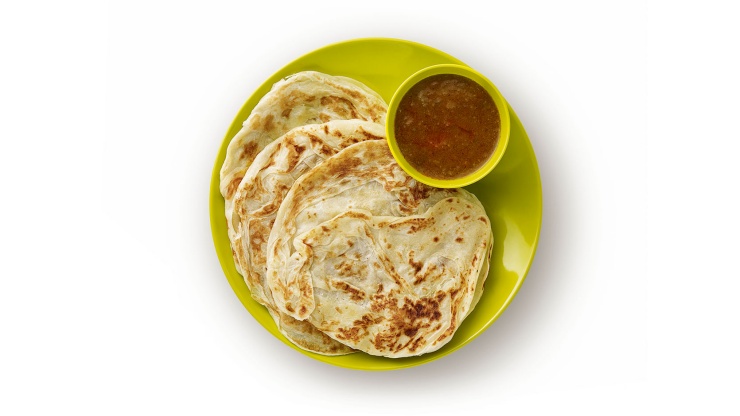
Photo courtesy of yoursingapore.com
Roti prata is a dish of Indian origins that comprises a fried flour pancake and is usually served with either a vegetarian or meat-based curry. The most common way to consume roti prata is similar to that of dipping bread into soup; tear off a piece of prata, dip it into the curry, and then pop it into your mouth for delicious, spicy goodness. To prepare roti prata, the dough is flipped several times high up in the air, much like a pizza, and is then fried on a flat grill.
4. Chilli Crab
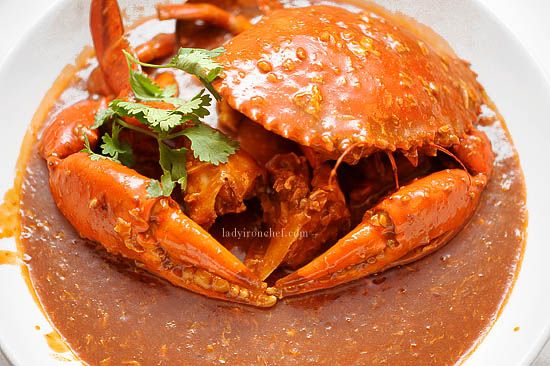
Photo courtesy of ladyironchef.com
Did you know that despite its name, chili crab is not actually a very spicy dish? This popular seafood dish was featured as CNN Go’s World’s 50 Most Delicious Foods in 2011 and is first stir-fried in a semi-sweet, thick, tomato and chili sauce. It’s traditionally eaten with hands so as to fully savor the crab meat, and some restaurants even serve hot, steamed buns to dip into the chili crab gravy.
5. Bak Kut Teh
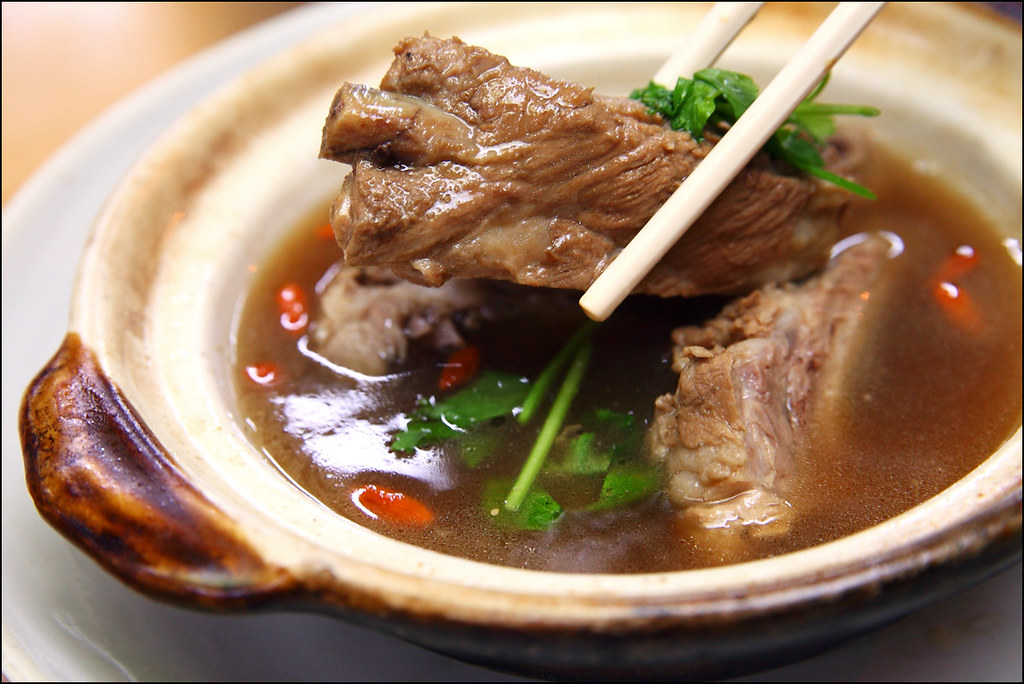
Photo courtesy of vkeong.com
Looking to try something that’s not as oily and fatty? Bak kut teh, or “meat bone tea,” is a broth of mixed herbs and spices and primarily contains steamed pork ribs and other vegetables. The dish was developed in Malaysia by Chinese immigrants in the 1930s, and there are three variations, with the Teochew version of bak kut teh being most commonly found in Singapore.
This style’s broth is lighter in color, and more pepper and garlic are used in the broth. Today, bak kut teh is frequently eaten with noodles or rice and served with strips of fried dough (you tiao) to dip into the soup.
6. Fried Carrot Cake

Photo courtesy of seriouseats.com
Unlike in the United States, Singapore’s version of carrot cake is hardly a dessert. Also known as chai tow kway, fried carrot cake is one of the most commonly consumed dishes for breakfast amongst Singaporeans.
There are two distinct types of fried carrot cake: the “white” version, which does not use sweet soy sauce and the carrot cake is fried on top of a beaten egg to form a crust, and the “black” version, where sweet soy sauce is used and the egg is mixed in with the carrot cake.
7. Wanton Noodles
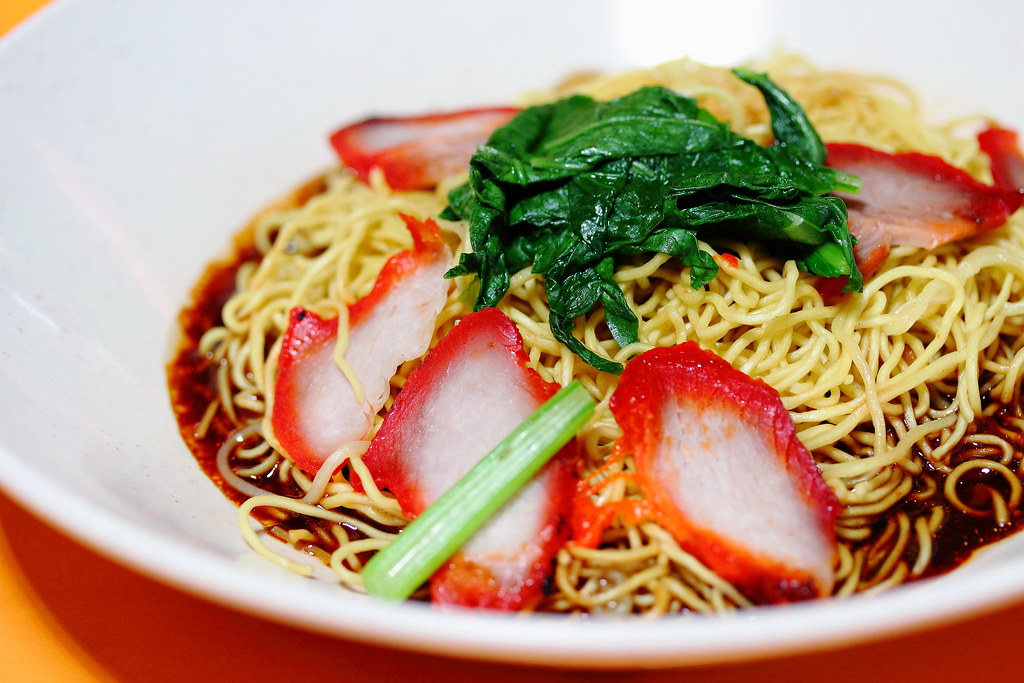
Photo courtesy of sgfoodonfoot.com
Singaporean wanton noodles include slices of char siew (barbecued pork), leafy green veggies, and egg noodles cooked al dente, and is usually served dry. Wantons are usually boiled and bite-sized, though some places commonly serve the dish with deep fried wantons.
Popular toppings for wanton noodles include hot chili sauce and deep-fried pork lard. Wanton mee is also a popular late night dish; there are several wanton mee cafes that are open late, and some even operate 24/7.
8. Ice Cream Sandwich

Photo courtesy of makansutra.com
Ice cream sandwiches in Singapore are literally ice cream sandwiches, a solid block of ice cream wedged in between a piece of bread or two pieces of crunchy wafers. These tasty treats are perfect for Singapore’s year-round summer weather, and can only be found at vendors situated in the downtown Orchard Road shopping area, Chinatown, in parks, outside schools, and areas with tourist attractions.
Photo courtesy of jeffreyandflora.com
Vendors are mostly run by senior citizens and are operated on motorcycles or bicycles to allow for easy mobility. The best part about these sandwiches? They sell for as low as a single dollar, making them an extremely popular treat among locals and tourists.
9. Char Kway Teow

Photo courtesy of danielfooddiary.com
Singapore’s local hawker scene has oodles of noodles, and this famous dish is one of the most popular within Southeast Asia. Char kway teow is best distinguished by the use of flat rice noodles, or kway teow, stir fried in high heat with cockles, fish cake, eggs, bean sprouts, Chinese sausage, prawns, and light and dark soy sauce.
It was originally invented for laborers as a cheap, easy source of carbohydrates and nutrients, hence its high saturated fat content, but today it’s a delicacy enjoyed by everyone. The state of Penang, Malaysia, is particularly world famous for its delicious char kway teow.
10. Rojak
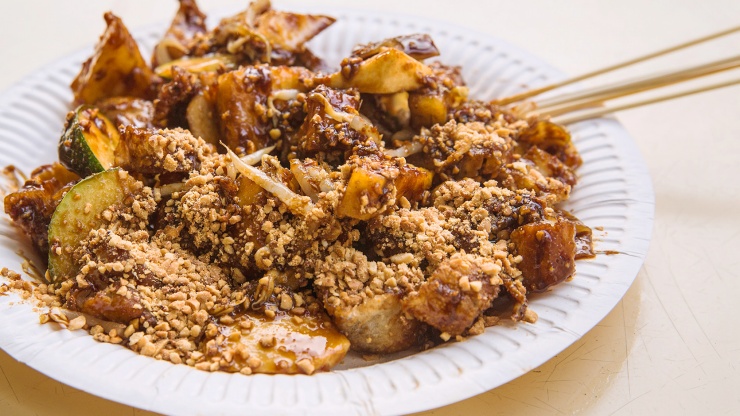
Photo courtesy of yoursingapore.com
Rojak is a traditional fruit and vegetable salad adorned with a spicy dressing. Although there are several variations of the dish, one of the most commonly consumed is one that comprises of fried dough fritters, tofu, boiled potatoes, prawn fritters, hard boiled eggs, bean sprouts, cucumbers and cuttlefish mixed with a sweet and spicy chili dressing.
11. Hokkien Mee

Photo courtesy of sg.asia-city.com
Singapore’s version of Hokkien Mee was created by Chinese sailors from the Fujian province after World War II. At the time of the dish’s invention, they would take excess noodles from noodle factories over a charcoal stoves.
Today, however, hokkien mee’s ingredients include bean sprouts, stir-fried pork belly, shrimp, squid, deep-fried shallots, spring onions, leafy greens, and freshly-squeezed lime juice, and the dish is served with sliced red chili, light soy sauce, and sambal (hot chili sauce) to give it that extra zing.
12. Laksa

Photo courtesy of rasamalaysia.com
Laksa is a spicy noodle dish consisting of rice noodles, prawns, and a variety of other toppings served in a spicy coconut based broth. Some common laksa toppings include boiled egg, fish cake, and bean curds.
In 2013, celebrity chef Gordon Ramsay challenged three local hawker centre stall owners to see if he could make better renditions of their dishes. Laksa was one of the three dishes in the Hawker Food Challenge, which Ramsay actually lost.
13. Ice Kacang
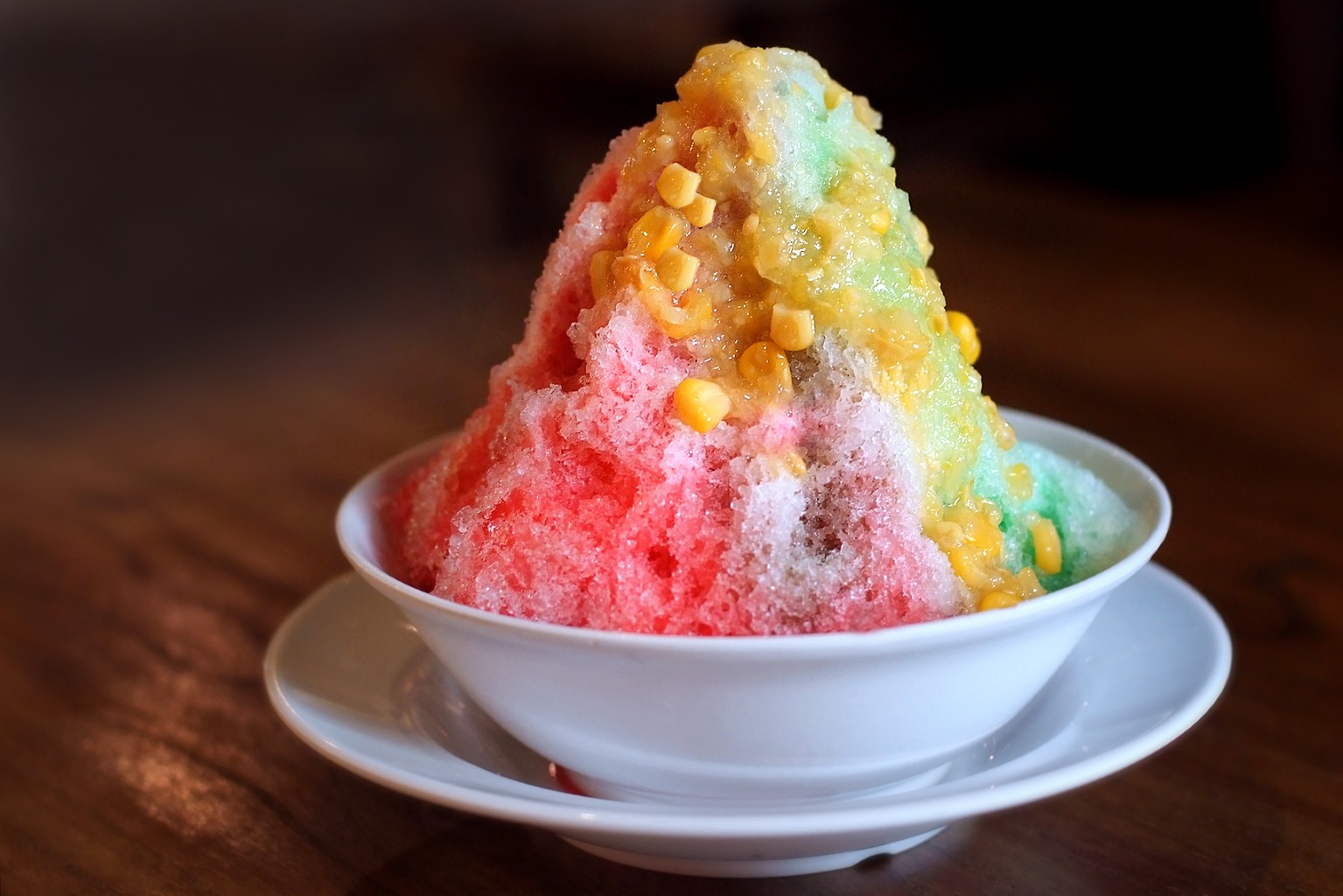
Photo courtesy of darrenbloggie.com
A popular coffee shop dessert, ice kacang was originally made of shaved ice and red beans, but other toppings now include multicolored syrups, sweet corn, grass jelly, and condensed milk. Some places even serve ice kacang with a scoop of ice cream. Although the dish originated in Malaysia, ice kacang is also popular in Singapore and Brunei.
14. Mee Pok

Photo courtesy of roseskitchenette.com
Mee Pok is a noodle dish of Chinese origins, characterized by the noodles’ flat and yellow appearance with various toppings that include minced meat, fish balls, stewed sliced mushrooms, and deep-fried pork lard.
It’s most frequently served dry, tossed in a light sauce that composes of vinegar, oil, soy sauce, and chilli (which is sometimes replaced by tomato ketchup for kids), but there are some places that do offer an option to have it in soup. If you decide to try the traditional, dry version of mee pok, hawkers generally serve it with a side bowl of soup.
15. Kaya Toast and Soft-Boiled Eggs

Photo courtesy of yakuntoast.wordpress.com
Incredibly simple and affordable, this combination is a common breakfast choice for many local Singaporeans. Kaya, a spread made of coconut milk, eggs, and sugar, is served on bread or toast and is the Southeast Asian equivalent of peanut butter and jelly sandwiches.
Along with soft-boiled eggs mixed in with dark soy sauce, kaya toast is often consumed with Kopi (coffee) or Teh (tea) and served in a kopitiam, a traditional Southeast Asian coffee shop. Popular chains of kopitiams in Singapore include Ya Kun Kaya Toast and Killiney.
16. Satay

Photo courtesy of healthxchange.com.sg
Satay comprises of seasoned, charcoal-grilled meat on skewers, and is commonly served with sides of sliced onions, cucumbers, and a spicy peanut sauce to dip. Meats used for satay include chicken, beef, and lamb, and the marinade used for satay is sweet, sour, and savory.
Although satay is originally from Indonesia, it is extremely popular in Singapore and is a great snack for parties and other events. Originally sold at makeshift roadside stalls and pushcarts, satay is now commonly found at open-air hawker centres. Singapore Airlines frequently serves it as an appetizer onboard to first and business class passengers on certain flights.


